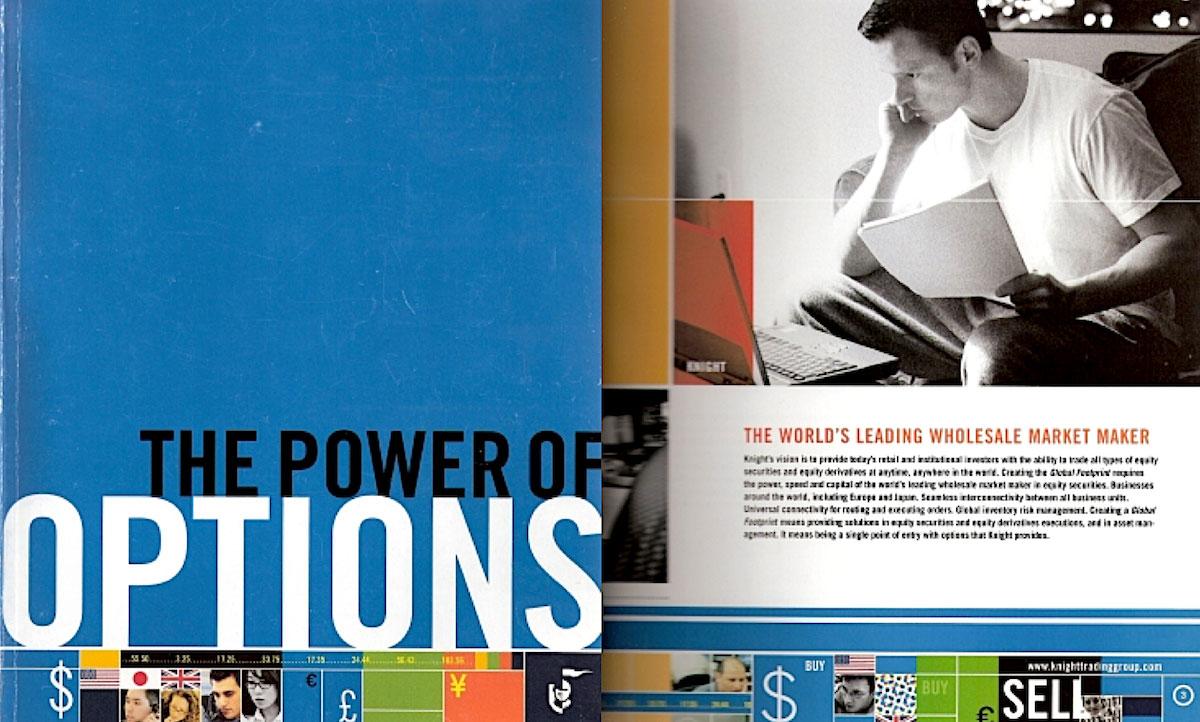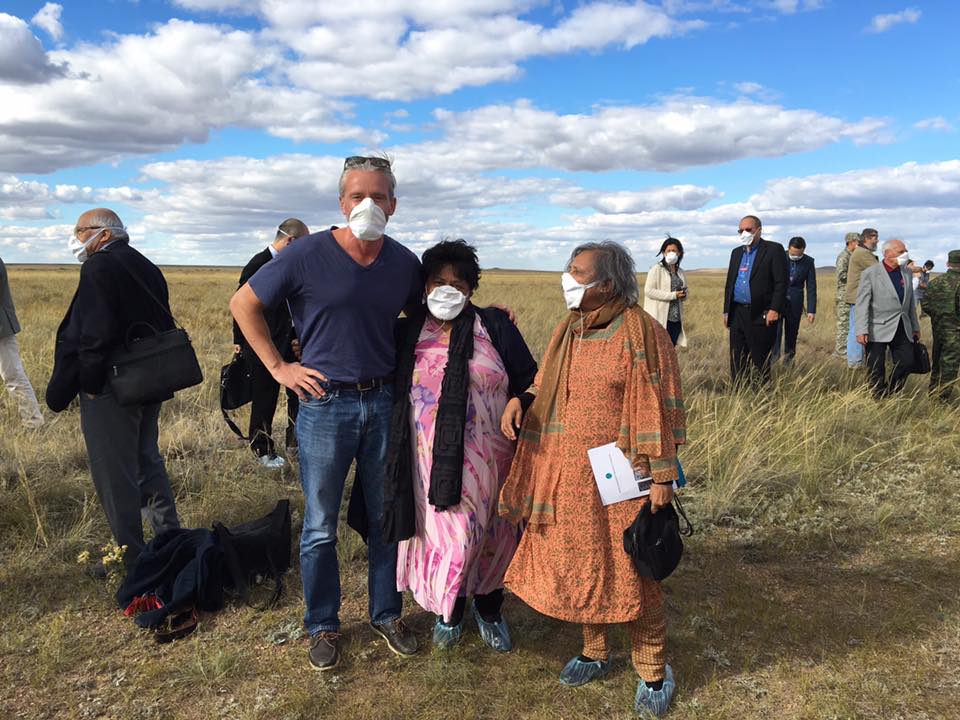Robert Smith entered the financial industry almost 30 years ago, with lessons passed down from four generations of family members who worked in the industry before him.
He learned about trading from his father; investment banking and investment management from his grandfather; institutional sales from his great-grandmother; and philanthropy and creating financial vehicles “in divine service to others” from his great-great-grandfather.
Early in his career, Robert managed firm capital and traders at the world’s largest market making firm and then the world’s leading proprietary trading firm.

Knight-2000-Annual-Report-1
Knight, 2000 Annual Report
After witnessing the attacks on New York’s World Trade Center, something shifted in Robert, and he took a sabbatical to reconnect with the divine in nature.
Two years later, he returned to New York City to pursue a new career in finance, one with meaning and human connection. He realized that if he had generated profits for family offices and institutional investors – the customers of the trading firms where he had worked – rather than for the trading firms themselves, he would have greater expansion and fulfillment.
Robert had observed that family offices were underserved by the institutional departments of investment banks and many lacked sophistication compared to fund investors who managed large pools of capital. He put this often ignored and vulnerable investor type at the center of his business, and, over a span of 12 years, Robert worked for two family offices on the buy-side, where he conducted company and manager due diligence, and – having built a book of business through idea generation, cold calling, networking, and good customer service – he led institutional equity sales, international equities and equity capital markets for two investment banks on the sell-side, where he participated in more than 200 transactions of private and public companies.
He had observed that family offices had a strong appetite for impact and seemingly most were not attending investor conferences, and so he founded Conscious Capital, Inc., formerly named ICV, Inc. (Investment Community Visibility) to connect family offices and fund investors in collaborative and safe environments to evaluate opportunities that create environmental and social impact beyond financial return.
Over the course of hosting 30 events, which were given to investors for free, he wanted to give them something else – the dream they did not know they had. Having strategically analyzed consciousness and cultures, beyond figures and portfolios, he identified possible unions, then lifted these unions to new levels with the amplification of consciousness to a new union that individually in singularity was unimagined but now realized. Robert brought together family offices, institutional investment managers, well-known musicians, artists, authors, actors, athletes, Nobel Prize Laureates, civil society leaders, key opinion leaders, government officials, Heads of State, Heads of UN agencies, entrepreneurs of innovative companies and founders of grassroots organizations.

Robert-Smith-Mary-Anne-Plaatjies-van-Huffel-and-Ela-Gandhi
Robert Smith with Mary Anne Plaatjies van Huffel, President of World Council of Churches (Africa) and peace activist Ela Gandhi, granddaughter of Mahatma Gandhi, at the test site outside Semey, Kazakhstan, where 456 nuclear bombs were detonated.
In 2018, Robert began creating financial vehicles in divine service to others – vehicles that would create plenty for the many.
That same year, he was inducted as a member of Evolutionary Leaders, alongside Deepak Chopra, Gary Zukav, Bruce Lipton, Gregg Braden, and others who feel a sense of urgency about the state of our world and are forging a movement for the conscious evolution of humanity.
He was also recognized by Real Leaders Magazine as one of the 100 Visionary Leaders, alongside Leonardo DiCaprio, Malala, Mikhail Gorbachev, Oprah, and others who are leading us towards a better world.

100-Visionary-Leaders-1
Real Leaders, Spring 2018
Today, Robert serves as Senior Advisor for Fundraising and Partnerships to the Permanent Secretariat of the World Summit of Nobel Peace Laureates, which organizes the Summit in different locations across the globe with the support of a number of Nobel Peace Laureates’ foundations and organizations, and in partnership with hosting municipalities and prominent local foundations.
He serves as International Trustee of Religions for Peace International, the world’s largest and most representative multi-religious coalition advancing common action for peace, since 1970, by working to advance multi-religious consensus on positive aspects of peace as well as concrete actions to stop war, help eliminate extreme poverty and protect the earth. The Religions for Peace network consists of a World Council of senior religious leaders from all regions of the world, six inter-religious regional councils, and ninety national councils, the Global Women of Faith Network, and the Global Interfaith Youth Network.
He serves on the Sustainable Investing Advisory Board of the United Nations Capital Development Fund (UNCDF), which makes public and private finance work for the poor in the world’s 47 Least Developed Countries (LDCs).
Robert serves as a member of the President’s Leadership Council of Thomas Jefferson University, the largest academic medical center in Philadelphia and recently named 16th on U.S. News & World Report’s 2017-2018 Best Hospitals Honor Roll, a distinction awarded to just 20 hospitals in the U.S.
Building upon his family’s commitment to provide “inspirational and tangible help for young people,” Robert serves as Senior Advisor to the Africa Rising Foundation, a nonprofit organization founded by Ndaba and Kweku Mandela, grandsons of Nelson Mandela, in order to contribute to the development of the African continent and serve as a conduit for the New African Generation that is committed to promoting Africa through a series of campaigns that address the continent’s socio-economic challenge; he serves as a member of the Board of Directors of the Chaeli Foundation USA, a nonprofit that focuses on growing more inclusive and empowered communities, especially through the inclusion of children, youth and adults with disabilities; he is a past member of the Board of Directors of Childhood Cancer Kids, a nonprofit that increases childhood cancer awareness and elevates the spirits of children with cancer; he serves as a member of the Board of Trustees of The Children’s Village, a nonprofit that works in partnership with families to help society’s most vulnerable children so that they become educationally proficient, economically productive, and socially responsible members of their communities; and, he serves as a member of the Chairman’s Circle of Tuesday’s Children, a response and recovery nonprofit organization that supports youth, families, and communities impacted by terrorism and traumatic loss.
The “deprivation of black Americans, he reasoned, was a national problem, not simply a burden on blacks alone”
– about William E. Harmon
Carrying On A Mission
Robert serves as Chairperson and a member of the Board of Directors of the Harmon Foundation, a private foundation established in 1922 by his great, great grandfather William E. Harmon for charitable and humanitarian purposes, with an emphasis on “inspirational and tangible help for young people” and a focus on grassroots nonprofit organizations.
William E. Harmon operated the Wood, Harmon & Co., the largest real estate company in the world at the turn of the century, where he developed the “partial payment plan.” After learning about the New York City subway extension, Harmon invested more than $4 million in Brooklyn, comprising over 20,000 building lots, more than any other, which was sold to New Yorkers on small partial payments after a surge in population.
“Land is the gift eternal,” said Harmon. “Buildings may crumble, endowments fail, but land is forever available. Fifty generations have used the playgrounds that were left as open spaces in the building of Rome, and these same playgrounds will be used for hundreds of generations. The land we set aside today in American towns and cities will serve the boys and girls not only of this generation, but of unnumbered generations to come” (The New York Times, October 23, 1921).
Harmon was fond of saying, “A playground now will be a playground forever, for land is the one thing that does not perish. And children will play!” He established a worldwide park system, including parks in 36 states, that were so named, “Harmon Playgrounds,” and often maintained through grants to real estate developers to beautify the parks.
Being the son of the only white officer to command the Buffalo Soldiers during the Civil War, the experiences of his father left an indelible impression on Harmon. As a businessman who believed it was absolutely necessary to change racial relations in the United States to create a situation where blacks could achieve some economic independence, Harmon inaugurated the Harmon Award in 1926 for distinguished achievements among African Americans in eight different fields: literature, music, fine arts, business and industry, science and innovation, education, religious service, and race relations. Harmon’s interest to support African Americans reflected “his interest in promoting justice and social commitment.”
Award recipients included Langston Hughes, William H. Johnson, Archibald Motley, Claude McKay, Countee Cullen, James Weldon Johnson and hundreds of others. The deprivation of black Americans, he reasoned, was a national problem, not simply a burden on blacks alone. The Harmon Award was best known for its impact on African American art of the Harlem Renaissance, with works by Richmond Barthé, Lois Mailou Jones, Augusta Savage first exhibited at the Smithsonian Institution in 1944, where the opening ceremony was attended by First Lady Eleanor Roosevelt, United States Vice President Henry Wallace, Howard University President Mordecai Wyatt Johnson, pioneering doctor and scientist Charles Drew, and writer and scholar Alain Locke. After the Harlem Renaissance, works of writers, artists and musicians were featured at exhibitions, including Against the Odds at the Newark Museum, where people could view paintings and sculptures, which had generally been thought of as elitist and upper-class, created by blacks. The Harmon Foundation film The Negro in Art was one fo the films that highlights the foundation’s promotion of African American art and documents the foundation’s Fifth Exhibition.
In 1927, John D. Rockefeller began campaigning for the “self-financing of education” and gained support from Harmon who created business-like loans, known today as the student loan, where character and group responsibility were used as the basis for credit. This effectively transformed the economics of colleges to depend on students’ payments. “While the Wall Street Journal described higher education as a ‘big business’ in 1930, even the Harmon Foundation expressed some caution about the viability of private student lending as a business model. ‘Loans to the amount of $1,000 to one student… would seem a sound practice. A student who is worth helping at all should be ‘seen through’ and it is not conceivable that anything below $500 would be of much assistance to him during his four years of college life unless it be for emergency purposes,’ a 1925 study published by the foundation noted (Source: Processhistory.org).”
Harmon made thousands of financial gifts under a fictitious name to “great writers, obscure poets, unsung heroes and good children” (The New York Times, July 16, 1928). He had chosen the nickname Jedediah Tingle, belonging to his great grandfather who died in 1827, and he carried on his ancestor’s mission, “to bring smiles and tender thoughts to the great in heart in high and low places, to comfort those who do exceptional things or suffer.” Over his lifetime, donations were made to 119 communities in 36 states. Among the recipients of Harmon’s largesse included Helen Keller who wrote about Jedediah Tingle, “an obscure poet or artist is very likely to find a letter and a check from Jedediah Tingle in his otherwise dreary assortment of morning mail. A mother working to send her boy through school, may hear from him. A hack writer, who has written a little article which shows understanding and love of his fellow humans, may hear from him; a factory worker who is sick, or an old woman who is alone and crippled with rheumatism may receive an unexpected message from Jedediah Tingle” (Boston Daily Globe, March 24, 1926). Upon his death, William E. Harmon’s secret of being Jedediah Tingle, the mysterious philanthropist, was revealed.
“My mission is to seek out the unappreciated genius, to encourage patient merit, to lift up the sick, and follow where misfortune has descended on noble souls, and you may well know that that keeps me busy”
– Jedediah Tingle to Helen Keller, Boston Daily Globe, March 24, 1926

